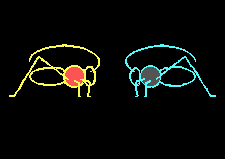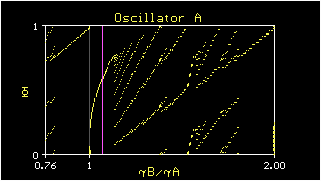Kyberniidae
by Klaus F. Steiner (1994)
Kyberniidae demonstrates the dynamics of two mutually coupled oscillators,
or in a more biological language: it simulates dueting males of the tropical
katydid Mecopoda elongata L. The model is based only upon phase
response curves and chirp cycle lengths.
The program uses experimental data I found in the process of my master
thesis "Dynamik des Gesangs der Laubheuschrecke Mecopoda elongata
L." (in English: "Dynamics of the calling song of the katydid Mecopoda
elongata L."). Kyberniidae is a part of my thesis, too.
Kyberniidae is written in Borland Turbopascal 6.0 for DOS.
I have to
apology, because Kyberniidae is not very user friendly, has no help system,
is keyboard controlled (no mouse) and some manipulations are a little bit
strange. And sometimes terminology within the program is inconsistent (e.g.
synonyms are animal=Tier=system=oscillator). The reason is that the genesis of
Kyberniidae was rather evolutionary than creational or logical.
Menu
Move menu cursor by pressing arrow keys <up>
and <down>. Select with <Enter>. Also you can make your selection
by pressing the key corresponding to highlighted (red) letter in menu items name.
Use <Esc> to go back from submenu or graphic screen.
- Chorusing
Coupling of two oscillators at which their endogenous chirp cycle lengths
are constant. When you first time enter one of the following menu items
you have to select the properties for the oscillators: for both you can choose
between two items: New animal:
a table (blue) will appear with data of my observed animals
(no idea what I'm speaking about? Read
Phase Response first).
Select an animal with arrow keys and .
Periodic: Constant rhythm, set
circle length between 1000 and 4000 ms (cycle length is constant, the other
oscillator can't influence this oscillator).
- Phase-Coupling-Map
The ontogenetic oldest part of Kyberniidae. You may ignore it! For
the sake of completeness: In the bottom left you can see the data
describing the selected oscillators
(Tier = animal; number: data from # animal; Tier C: constant rhythm).
Over that you find their PRCs
graphical coupled (PCM, phase coupling
map). Figures "Attraction" show in which phases interactions
will converge and how many cycles are needed at the most. In
Figures "Entropy" you see reduction of Entropy from cycle to
cycle (it depends on programs use of discrete PRCs that Entropy
is greater zero sometimes although there is obviously just one globally
stable fixpoint). Back to menu with .
- PRCs + Poincaré Maps
This is a static graphic screen, too.
Phase response curves of selected
oscillators are shown. Under that you can see the Poincaré maps
for both oscillators. A Poincaré map shows phase of the others chirp
against phase of the others next chirp in animals chirp cycles.
-
Simulation
 Realtime simulation of duetting animals.
Two animals (yellow and blue) are drawn. Red thorax indicates that animal
chirps, gray thorax that it's silent (see figure). Simultaneous the chirps are recorded
in an oscillogram (color like singing animal).
A gray "partition" wall
between the animals separates them acoustically - by pressing
the wall can be switched off and on (on=violett and off=gray line in oscillogram).
Chirps can also be given as sound (press key 'S'), but don't do this
on PC's other then 486-33, else sound is horrible!
With keys '1' and '2' you can inactivate/activate the yellow (1) and
blue (2) animal. 'p' pauses the simulation. Pressing 'r' clears the
oscillogram (and trajectories if other digrams are displayed) but doesn't influence
the animals' songs. Back to menu with 'Esc'.
Realtime simulation of duetting animals.
Two animals (yellow and blue) are drawn. Red thorax indicates that animal
chirps, gray thorax that it's silent (see figure). Simultaneous the chirps are recorded
in an oscillogram (color like singing animal).
A gray "partition" wall
between the animals separates them acoustically - by pressing
the wall can be switched off and on (on=violett and off=gray line in oscillogram).
Chirps can also be given as sound (press key 'S'), but don't do this
on PC's other then 486-33, else sound is horrible!
With keys '1' and '2' you can inactivate/activate the yellow (1) and
blue (2) animal. 'p' pauses the simulation. Pressing 'r' clears the
oscillogram (and trajectories if other digrams are displayed) but doesn't influence
the animals' songs. Back to menu with 'Esc'.
- Simulation + PCM
Like (3) but additionally with animated PCM (see 1). Trajectories will be drawn in PCM,
fixpoints will be marked with a green circle (see Examples 1-3).
- Sim + PRC + Poincaré
Like (3) but additionally with animated PRCs and Poincaré maps (see 2).
Trajectories will be drawn in PRCs and Poincaré maps, fixpoints will be
marked with green circles.
- New oscillators
If you want to stay in submenu chorusing here you can select new oscillators.
As described above but additional
Don't change: the preselected
oscillator stay the same.
- Bifurcation
Coupling of two oscillators at which ratio between the endogenous chirp circle
lengths is varied within a given interval. Like in "Chorusing" you have to select
the animal's properties first, for second animal you have
to define a range for endogenous chirp circle length and the width of steps within.
The chirp cycle length are given in ratio between both animals
(t...endogenous circle length of the animal
indicated by index; indices: A..first selected, yellow animal, and B is the other one).
For every step
in this interval the phases in stationary states become computed.
-
Coupled Phases
The upper diagram on the left shows phases of blue's (the second one) chirps
in yellow's chirp circles (see figure). Below the same diagram, but with reversed
actors' part (see Example 4.
Move cursor, the red vertical line, with arrow keys left and right
(faster with ), then press -
the PCM will occure. Key toggles between
PCM and Poincaré maps.

- Cycle Length
Instead phases in stable state the cycle length are displayed in the left diagrams.
Everything else is like before.
- Oscillator A
For the yellow animal (oscillator A) diagrams "phases" and
"cycle length" are displayed.
- Oscillator B
Like (3) but diagrams for blue animal.
- New oscillators
You can select new animals and range of circle lengths.
- Quit
This closes program Kyberniidae
Some Examples
Some screenshots from Kyberniidae. More detailed descriptions and
further examples of Kyberniidae will come soon.

Fig. 1: Animal (yellow) phase couples to a constant singers
rate ("deaf animal"; blue). Green circle marks the stable point. Display of
Chorusing | Simulation + PCM

Fig. 2: Interaction of two mutually hearing animals. For
these two animals there are two stable patterns of interaction. In this
screen shot you can see stable alternation ... (compare with next Example)

Fig. 3: ... and here imperfect synchronization. The animal
with the faster freerun (blue) starts its chirps short time earlier then
the endogenous slower, yellow one (compare with previous Example)

Fig. 4: Phase relationship between an animal (yellow)
and constant chirp rates (stimulus) from 0.76 to 2.00 times the animals
chirp rate. At the violet line (left diagrams) we find 5:6 stimulus:animal
coupling; the attractor is shown by the green lines in the Poincaré
maps, too (Poincaré map: phase of the others chirp in this chirp
circle plotted against phase of others next chirp in the next disturbed
chirp circle). Display of
Bifurcation | Coupled Phases
 Realtime simulation of duetting animals.
Two animals (yellow and blue) are drawn. Red thorax indicates that animal
chirps, gray thorax that it's silent (see figure). Simultaneous the chirps are recorded
in an oscillogram (color like singing animal).
A gray "partition" wall
between the animals separates them acoustically - by pressing
Realtime simulation of duetting animals.
Two animals (yellow and blue) are drawn. Red thorax indicates that animal
chirps, gray thorax that it's silent (see figure). Simultaneous the chirps are recorded
in an oscillogram (color like singing animal).
A gray "partition" wall
between the animals separates them acoustically - by pressing 



